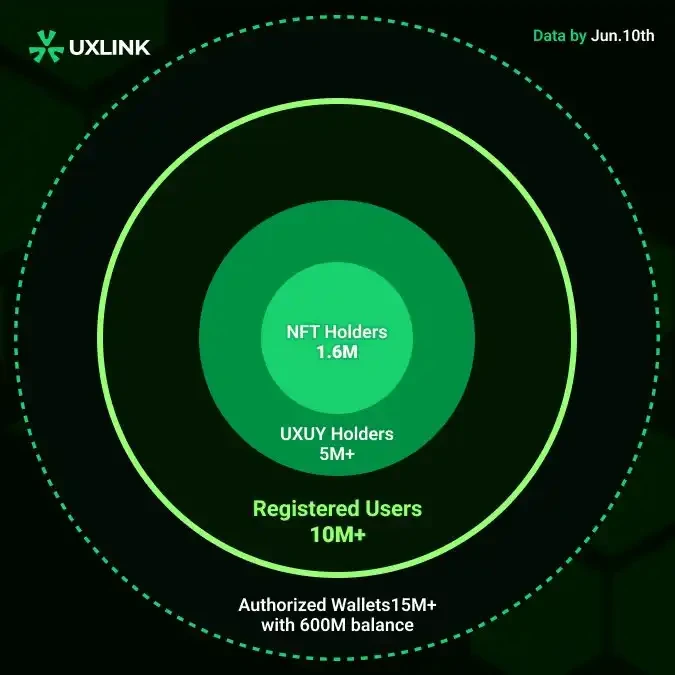本日、UXLINKは登録ユーザー数が1,000万人を超え、Web3 SocialFiカテゴリーでユーザー数が数千万人に達した最初の製品になったと発表しました。このデータについて、UXLINKコミュニティのテクニカルディレクターに早速インタビューしました。
画像出典: UXリンク
1. ほとんどのブロックチェーン プロジェクトは、独立したウォレット アドレスの数で測定されます。UXLINK が登録ユーザー数という指標を提案するのはなぜですか? それと独立したウォレット アドレスの数の違いは何ですか?
これは主に次の 2 つの問題を解決するために使用されます。
(1)Cryptoには無効で偽のSybilウォレットアドレスが多すぎますが、これらは意味がなく、データを汚染します。
(2)私たちはソーシャルであり、人/アカウントという概念を提唱しています。なぜなら、人々が互いにつながって初めてソーシャルとみなされ、人は異なる目的で複数のウォレットを持つことができるからです。
そのため、登録ユーザーの概念を使用して測定し、登録ユーザーは次の 3 つのレベルを通過する必要があります。
(1)100%招待関係、Link-to-Earnを通じて入場、新規ユーザーはUXLINKネットワークの知人やパートナーから招待され、招待コードで登録する必要がある
(2)ボットではないことを証明するには、人間とコンピュータの相互作用が必要である
(3)UXLINK製品の使用
上記の基準を満たしている場合は、UXLINKの登録ユーザーとしてカウントされるため、登録ユーザー数は独立したウォレットアドレスの数よりも少なくなります。現在、UXLINKの登録ユーザー数は1,000万人を超え、接続された承認済みウォレットアドレスの数は1,500万です。各ユーザーは複数のウォレットを持つことができます。
すべてのユーザーはウォレットを持っていますか?はい、ユーザーがWeb2から来てウォレットを持っていない場合、私たちは彼にMPCウォレットを提供します。このウォレットに当面資産がなくても、このユーザーがコミュニティに貢献すれば、彼も優れたユーザーです。ソーシャルマスアダプションは私たちの使命であり仕事です。UXLINKネットワークのユーザーの100%はWEB3ユーザーであるとも言えます。
すべてのウォレットはユーザーですか? 必ずしもそうではありません。私たちは、ソーシャル検証、多様なタスク、アクセス検証、サードパーティの評判システムなどの方法を使用して、ウィッチを防ぎ、何千万もの無効で偽のウィッチウォレットアドレスをブロックします。もちろん、実際のユーザーに害を及ぼさないように、すべてをブロックすることはできません。
すべてのユーザーがソーシャルメディアアカウントを持っているのでしょうか?必ずしもそうではありません。当社はユーザーのプライバシーを完全に尊重しています。ユーザーの中にはウォレットのみを持っている人や、ソーシャルメディアアカウント経由でログインして、その後ソーシャルメディアアカウントをキャンセルする人もいます。当社は今後も優れたサービスを提供していきます。
2. UXUY Holders の概念とは何ですか? トークンの保有者の数ですか?
まず、UXUYはUXLINKのオンチェーンPOWポイントの一種で、コミュニティユーザーの成長と交流を記録し、促進するために使用され、譲渡できません。UXUYはすべてLINK 2 EARNの公式を通じて生成され、予約なし、事前ミントなしであり、すべてコミュニティユーザーのPOWマイニング出力から来ています。キーワードはPOW、オンチェーン、譲渡不可です。
UXUY 保有者は 3 つの基準を満たす必要があります。
1. 登録ユーザーのウォレット
2. コミュニティが設定したPOW行動に貢献し、UXUYを獲得する
3. チェーン上でUXUYを請求します。つまり、請求がない場合はUXUY保有者としてカウントされません。
したがって、UXUY ホルダーはコミュニティ貢献者、WEB3 ユーザー、および潜在的なガバナンス トークン ホルダーです。現在、UXUY ホルダーは 500 万人います。
UXUY 保有者の数は増えますか? はい、コミュニティの継続的な貢献により、登録ユーザーが 3,000 万人を超え、UXUY が採掘されるまで増加します。その頃には、非常にポジティブなネットワーク効果が形成されていると考えています。
UXUY保有者の数は減少しますか?はい、一部の保有者がUXUYをNFTやガバナンストークンなどの他の資産と交換すると、数は減少します。
3. UXLINK のホルダーは何人いますか? 基準は何ですか?
NFT 保有者を測定するための 3 つの側面は、コミュニティへの貢献、オンチェーンの相互作用、ウォレット アドレス内の資産数です。
TGE前のアプローチは次のとおりです。UXUY保有者は、UXUYが一定のレベルに達した後、UXUYを使用して異なるレベルのNFTを交換します。NFTはエアドロップの証明書であり、TGE前にNFTのレベルと数量に応じて$UXLINKが取得されます。その時点で、別のde-Wyrkプロセスが実行されます。
つまり、簡単に言えば、TGE前はNFT保有者=トークン保有者
TGE 後、保有者数には、購入してコミュニティに引き続き貢献する者を含む、すべての合法的かつ正当な uxlink 保有者が含まれます。
現在、保有者は 160 万人おり、流動性が解放されるにつれてこの数は増減します。
4. 登録ユーザーや保有者が非常に多いため、ウィッチ除去を実施するのでしょうか?
もちろん、WEB3 ではウィッチ アカウントが非常に一般的です。ウィッチを削除する最大の目的は、コミュニティ内の本物の質の高いユーザーの利益を確保することです。私たちはこれを 3 つのステップで実行します。
ステップ 1: ヒューマンマシンまたはアクセスコンプライアンス検証に基づいて、偽のリクエストかどうかを判断します。システムから直接ブロックするため、登録ユーザーとはみなされず、LINK-TO-EARN から UXUY も生成されません。このステップでほとんどのリクエストをブロックできますが、厳しすぎると実際のユーザーに悪影響が出るため、厳しすぎるといけません。
ステップ2:UXLINKネットワークに入ると、UXUYが生成されます。コミュニティの貢献とアクティビティに基づいて、再度削除されます。たとえば、6か月間アクティビティがない場合、またはUXUYの請求が成功しなかった場合、チェーンされていないUXUYはリサイクルされ、コミュニティに循環され、高品質のユーザーにインセンティブを与えます。これは、コミュニティに真に価値をもたらすユーザーだけにインセンティブを与えることを保証するための再分配プロセスです。
ステップ 3: TGE の前に、コミュニティは別のラウンドのウィザード解除を実施します。方法はコミュニティによって発表され、リサイクルされた UXUY はコミュニティに再び入り、高品質のユーザーにインセンティブを与えます。
上記の 3 つのステップを通じて、コミュニティの品質、公平性、効率性が保証されます。
5. 多くのメディアがUXLINKとNOTCOINを比較し、UXLINKのオンチェーンデータはNOTCOINよりも優れていると言っています。どう思いますか?
UXLINKとNOTCOINは異なる分野に属しており、1つはソーシャルプラットフォームとインフラストラクチャであり、もう1つはゲームです。この2つにはいくつかの類似点があります。どちらもマスアダプションをミッションの1つとして掲げており、ユーザー数が多いです。私の観点からすると、NOTCOINは全体的なユーザーベースが大きく、UXLINKはオンチェーンデータとユーザーの粘着性が高くなっています。たとえば、チェーン上の1日および1か月のアクティブユーザー、1日アクティブユーザーと1週間アクティブユーザーの比率、1週間アクティブユーザーと1か月間アクティブユーザーの比率はすべてNOTよりも高く、チェーン上の月間アクティブユーザーの割合は、登録ユーザー全体の50%以上を占めています。UXLINK保有者数もNOT TGE以前よりもはるかに多くなっています。
主な理由は3つあると思います。
(1)ソーシャルプロダクトにおけるユーザーインタラクションは、ゲームにおけるインタラクションよりもはるかに深い。ユーザーは、SBT/SocialGraph、グループ、招待、学習チェックインなどのソーシャルインタラクションだけでなく、SWAPなどの資産関連のインタラクションにも参加する。 エアドロップ、そしてプレマーケット。ただし、NOTCOINのインタラクションは比較的純粋で、Tap-to-Earnであり、比較的浅いです。深さは、良いか悪いかに関係なく、トラックによって決まります。
(2)ユーザーの定着率は、社会的関係やグループと関係しています。現実世界の社会的関係と当社の10万を超えるグループは、信頼と高いユーザー定着率をもたらします。
(3)全体的には、これは前述のUXLINK登録ユーザーの選別とも関係している。3回のアンチウィッチとデウィッチを経て、登録ユーザーの総数は減ったようだが、質は向上した。
UXLINK and NOTCOIN are both very good products, and they do provide effective paradigms from web2 to ウェブ3; from offchain to onchain. We need to learn from NOTCOIN in many aspects, and we are very much looking forward to working with NOTCOIN.
最後に、テクニカルディレクターとして、UXLINKの今後の製品開発や方向性をどのようにお考えですか?
私たちの本質に立ち返ると、私たちは知人同士のソーシャル関係を通じて信頼を築き、同時にユーザーにソーシャルプラットフォームと開発者のインフラを提供します。将来的には、エコシステムパートナーと協力して、ソーシャル化された資産生成、フロー、配布レイヤーを構築し、クロスチェーンなどの複雑なやり取りをすることなく、ユーザーがさまざまなアプリケーションを信頼できる、安全でシンプルな方法で使用し、独自のソーシャル資産を通じて利益を得ることができるようにします。開発者は、当社のプロトコル、ソーシャル関係、データを最大限に活用し、モジュール製品とAPIを通じて開発効率と成長品質を大幅に向上させることができます。
この記事はインターネットから引用したものです: UXLINKs ユーザーデータに関する 5 つの質問
Related: SEC Commissioner and Cryptocurrency Defender Hester Peirce Talks About Regulation: Ive 蜂n Very Frustrated in the Past
原著者:ダニエル・クーンはコンセンサス誌の副編集長です。 原文翻訳:デバイ、ウーがブロックチェーンについて語る 激しい反対意見から「クリプト・ママ」として知られるヘスター・ピアースは、SECの運営方法、暗号通貨の繁栄を望む理由、そして「セーフハーバー」提案によってプロジェクトの分散化が可能になる方法について語りました。 SECは単一の機関ではありません。 ヘスター・ピアース、別名クリプト・ママは現在、5人の規制委員の1人として2期目を務めています。 過去数年間、ピアースは暗号通貨とブロックチェーン技術の擁護者として知られるようになり、SECが暗号通貨プロトコルや企業に対して起こした多くの法的措置について、多数の反対意見を書いています。 ある程度、ピアースとSEC議長ゲイリー・ゲンスラーの意見の不一致は、彼らの…








